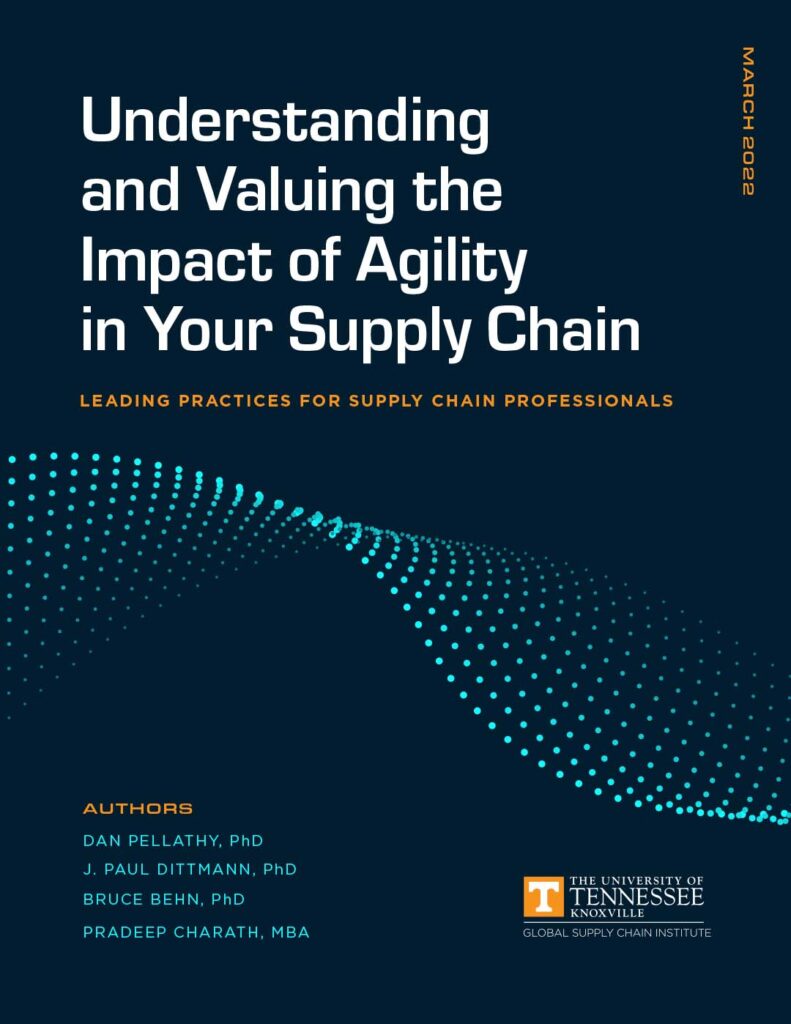How Investing in Supply Chain Agility Pays Off
How to Tackle Supply Chain Challenges and Incorporate Agility, Long-Term Profitability, and Supply Chain Best Practices into Your Strategy
“Understanding and Valuing the Impact of Agility in Your Supply Chain”
Providing Guidance to Develop Agility and Respond to Unexpected Events
A White Paper by the University of Tennessee Global Supply Chain Institute
More Information on this White Paper
What's Inside
Supply chain issues mean disruption for both consumers and companies. Supply chain disruption results in irritated customers and frustrated organizations. The solution: supply chain agility.
If you’ve followed the news or shopped, even casually, for cars, home renovation supplies, or baby formula, over the last few years, you’ve likely experienced supply chain shake-ups personally. And you know they’re unlikely to go away any time soon. So as a supply chain leader, how can you successfully pivot to an agile and profitable supply chain strategy?
Many supply chain leaders react to supply chain issues, fearful of the losses that may come from change. But supply chain agility breaks this pattern, enabling companies to maintain a managed response to change focused on capturing opportunities.
This white paper presents research by its authors about the benefits of investing in supply chain agility, which will increase company profits over the long term, and provide flexibility to continue operations during both adverse conditions and adventurous situational opportunities. Some best practices that supply chain leaders can adopt include:
- Targeting investments across three broad categories: digital agility, physical agility, and process agility
- Building a culture of cross-functional work that supports innovation and risk taking
- Using real-time data and visibility tools to facilitate a faster, more agile decision-making process
- Focusing on product simplification, stock keeping unit (SKU) rationalization, and cycle time compression
- Investing in key supply chain partners to drive transparency, collaboration, and commitment to joint supply chain goals
Upon download, you’ll find even more information, including:
- Helpful supply chain agility definitions, foundational information, and supply chain best practices
- Six tough questions to navigate with your companies’ leaders and decision-makers
- Dozens of interviews with industry leaders
- Key research findings, such as:
- Key barriers to investing in supply chain agility
- Guidance for identifying and valuing agility projects
- Best-in-class practices for building a more agile supply chain
- Examples of successful supply chain agility initiatives through vulnerable times
- Practical advice for supply chain agility implementation
- Tools for building the case for investing in agility projects for overall business success
- A Supply Chain Self-Assessment Tool
- Five agility improvement actions that supply chain leaders can take today
- And more
A preview from this white paper:
“When the COVID-19 pandemic struck, producers of personal hygiene products scrambled to keep up with demand. The problem for many companies was finding additional capacity. One supply chain executive we spoke to illustrated the point. According to internal projections, his company could have sold 400% more personal hygiene products over the first six months of the pandemic. But years of cost-cutting had eliminated any slack capacity and alienated suppliers. Those sales—and the customers behind them—went instead to competitors that had invested in flexible equipment and built long-term relationships with key supply chain partners.
This executive’s experience is not unique. Despite the considerable costs associated with disruptions, many companies have no process for reviewing investments in supply chain agility that would allow them to respond to unforeseen events…”
Benefit as a supply chain leader by giving this paper a deeper read.
Download now to start working towards a more agile, and profitable supply chain strategy.
Who This is Primarily For: Corporate CEOs, Supply Chain Professionals, Procurement Executives, Chief Supply Chain Officers, Chief Procurement Officers, Supply Chain Leaders, and Supply Chain Students.
